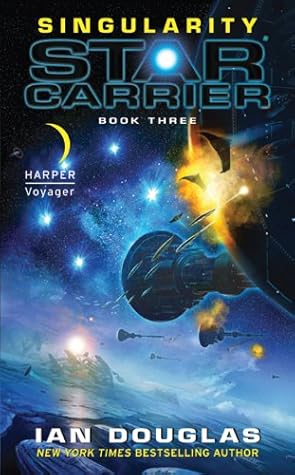Kindle Notes & Highlights
In fiction, such things had been called star gates, jump gates, jump portals, and a dozen other names. In physics, they were termed Lorentzian wormholes, Schwarzchilde wormholes, or Einstein-Rosen bridges, but all of the names meant the same thing: a means of warping local space so tightly that a tunnel or doorway was opened between two points in spacetime quite possibly very far removed from each other. Albert Einstein and Nathan Rosen had first postulated the idea of the Einstein-Rosen bridge as early as 1935, though the structure they’d proposed mathematically would have collapsed. Other
...more
Omega Centauri, also designated as NGC 5139, was unusual among known globular clusters. For one thing, it was one of the largest known—the largest globular of all such in Earth’s galaxy, and second only to the Andromeda’s Mayall II in the entire local group of galaxies. It was one of very few globulars actually visible to the naked eye, appearing as a fuzzy patch in the skies of Earth’s southern hemisphere just 17 degrees northeast of the brilliant and relatively nearby Alpha Centauri. Normally, it was visible from Earth as a fuzzy, third-magnitude star. When viewed in an absolutely black
...more
Gray walked a few meters forward, looking for something—and found it behind a nearby mass of feathery purple vegetation. As he pushed the plants aside, he revealed one of Heimdall’s cliff faces, just a meter and a half tall, polished and smoothed into a gleaming wall of silver, with what appeared to be circuitry diagrams imprinted in the metallic face. In his era, this cliff was much higher, heavily eroded, and looked like nothing more dramatic than a shelf of exposed rock with odd patterns of metallic stains, only just recognizable as the product of technology. But this . . . He reached out
...more
“All of these . . . these beings together,” Gray said after a moment, “are the Sh’daar. An entire galaxy of worlds and civilizations, working together in something like our Confederation, but a billion years ago.”
The point was that Gray was simply unable to expect that authority in any form would ever come to his rescue. From experience, he’d learned that Admiral Koenig and the other senior officers of the battlegroup did care, that they did their best to live up to the ancient dictum of no person left behind. It was one thing to know that, and quite another to feel it.
“The Sh’daar—the Refusers—never understood precisely what happened with the Schjaa Hok, the transcendence. They felt . . . abandoned. Even as they rebuilt much of the fallen galactic civilization, they . . . feared what had happened, and they feared what might yet happen if they or other species reached a similar technological singularity and transcended as well.”
There’d been endless speculation about the true nature of the Sh’daar, of course, ever since their Ultimatum in 2367. An advanced civilization ruling the galaxy, existing for millions, even for hundreds of millions of years . . . no. Koenig never had liked the term Sh’daar Empire. The galaxy was simply too vast to permit such shallow and shortsighted terminology. Evidently, the Sh’daar had agreed with him. They’d hoped to infiltrate the future by bypassing almost a billion years, pruning away those species that threatened their plans, co-opting the rest into nonthreatening acquiescence. Koenig
...more
The Sh’daar, it seemed, were as terrified of temporal paradox as they were of technological singularities. The grandfather paradox. It was as well established in the realm of scientific myth as Schrödinger’s cat. Build a time machine. Travel back to the past and kill your grandfather. You are never born, hence you can not travel back in time and your grandfather lives, so you do build the time machine and you do kill him, and on and on and irreconcilably on.
But at the heart of Omega Centauri, under the fierce and unrelenting glare of the Six Suns, there was the possibility that the invading humans of CBG-18 would cause unexpected and unplanned-for havoc with the Sh’daar vision of the future. Exactly what that havoc might be was unknown, and the Sh’daar, understandably, were reluctant to discuss it. Perhaps there were other gates here, leading still further into the past—those two new TRGA wormholes in the skies of AIS-1, perhaps. Reinforcements had come through those gates; suppose the knowledge of the battle here and now changed decisions made
...more
“I wonder,” Koenig said quietly, “what Geneva is going to think about this?” “They’ll call it,” Buchanan told him, “Independence Day.” “Eh?” “Look at the date.” Koenig had to query the fleetnet. July Fourth was not widely celebrated in the United States of North America nowadays, but it had been significant in the history of the old United States.
And with the War’s end, a feverish period of rebuilding and reconstruction had begun, as though both North America and the Pan-European Federation had suddenly decided to emerge from a long and groggy malaise. Mail packets had brought word of the Battle of Omega Centauri back to Sol weeks before, and the news appeared to have galvanized the civilian governments. The Periphery was to be reclaimed, and the rebuilding had begun. Eight kilometers to the south, the centuries-old Verrazano Sea Gates were being repaired. When they were operating once more, they would rise above the surface of the
...more


